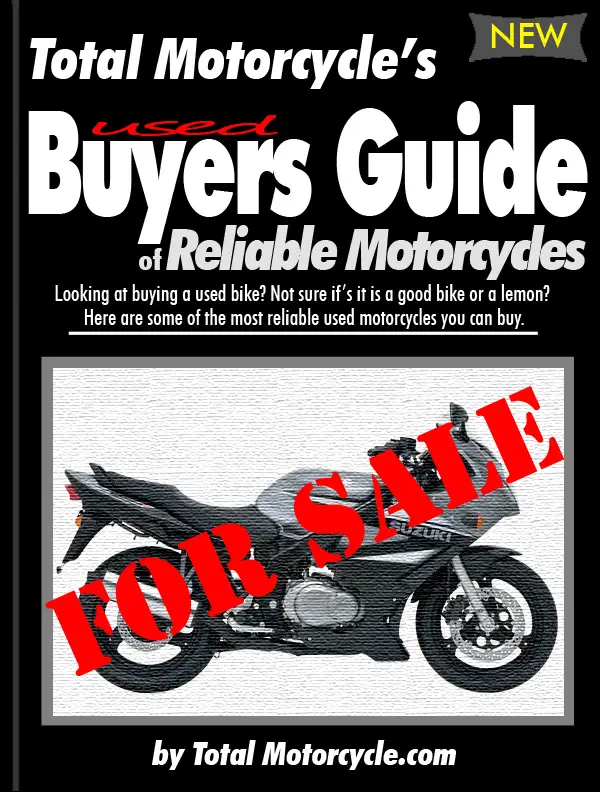|
Reliable Used Motorcycle Buyers Guide
– Introduction – |
||||
Introduction Sections:
– Forward
– How to find a reliable used motorcycle and what to look for
– Tip #1 – Generally horsepower and torque is not conductive of reliability.
– Tip #2 – A Motorcycle on the Jenny Craig program is not healthy.
– Tip #3 – Move less, live Longer
– Tip #4 – Lower beats per minute, more relaxed state.
– Tip #5 – Age of design.
– Conclusion
– Legend – How to read the Buyers Guide
Websites
Forward:
Motorcycling is back in full force popularity again and we are no longer in the 1980’s slump. People from all walks of life are again enjoying the sport of getting on a motorcycle and getting out into the great unknown. Many of the new riders to the sport are the baby boomers who started the whole motorcycle generation back in the 60’s, but we see the brand new rider as well. Maybe those brand new to the sport were inspired by the baby boomer generation of motorcyclists, or competition riders on TV but for whatever reason they have chosen to get ride a motorcycle we can only thank you for keeping the sport alive and thriving today. If you would like to learn more about the past and the future of motorcycling, click here for a special section on this site.
While there are quite a few great motorcycle buyers guides out there in books and on the Internet, I could not find a good used motorcycle buyers guide that focused on the best consistently reliable motorcycles produced. This led to three years of research to come up with this guide you see on the Total Motorcycle Website today. Along the way I talked to way too many motorcycle owners, clubs, read too many magazines and even worked for a used motorcycle mechanic for the whole summer and picked his and his customers brains about bikes. I do not pretend to be an expert or know-it-all, but I’ll share what I’ve learned along the way and fix it when I learn differently.
So, what we need is some type of reliability standards that most people can agree to. The standards I use is:
– If the majority of a certain model is good then the overall bike design is a good one.
– If a survey of motorcycle shops shows they do not get very many (if any at all) of a certain model for any major repairs than it must be reliable. If the same is true about minor repairs, then it must be very reliable.
– If you still see them on the road 20 years later then that says something about the design and reliability as well.
– If parts are dirt cheap on eBay for that model then that could mean there is no market for replacement parts since the original ones don’t really wear out that great. (Ignore this rule for rare and collector bikes).
– If a motorcycle magazine reviews an original model after 10+ years of it being introduced and still says very good things about it, that is very good.
– If you find owners not wanting to part with a 10+ year old model (even if they can afford a new(er) one) then there is something to be said about that.
Ok, so you are now getting a basic idea of the reliability standards we are talking about here then.
I hope you enjoy the Reliable Used Motorcycle Buyers Guide and use it often.
How to find a reliable used motorcycle and what to look for:
I like the expression: “While most improbable it is not impossible” and that can sum up every used motorcycle of every model ever for sale. Some people will have the world’s worst motorcycle commonly known and take it around the world, own it all their lives, put 250,000 miles/kilometers on it and never have an once of trouble. While 80% of those same models didn’t last and were problematic as soon as they left the showroom, Go Figure!
This might come as a shock to you but Manufacturers actually design inherent flaws into the design. Like the lightbulb, they can (and have) made them to last forever, Edison’s original light bulb is still on for over 100 years and hasn’t died yet! So if they made motorcycles that reliable, there wouldn’t be any motorcycle manufacturers around since there would be no profit in it. But sometimes, they put together something REALLY good that lasts and lasts and it is these chance motorcycle is what you should look out for.
So, you are probably wondering how do you know if UVW model motorcycle is more reliable than XYZ model? Well, let me tell you some trade secrets then…
Trade Secret Tip #1:
Generally horsepower and torque is not conductive of reliability.
Everyone likes horsepower and torque and lots of it please. It is fun, cool and all the rest, but in the long run it can be quite destructive on the engine. A motorcycle engine is small compared to a car, but they easily pack loads of horsepower and torque in there. The more you pack into an engine the higher you stress that engine and it’s design. Folks, that isn’t good if you want the engine to last a long time.
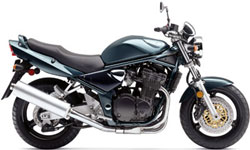 To put it into perspective, it is prestigious to own the most powerful motorcycle in its class, but unless they designed that engine super well, then it is like burning the candle at both ends. What you should look for is an “average” powerful bike in the category of its time, or a sleeper engine. Take the new Suzuki Bandit 1200 for example, 98.5hp for a 1200cc engine. You look at that versus the GSX-R750 with 145hp for a 750cc engine. Now what engine do you think is stressed? What engine do you think should last longer?
To put it into perspective, it is prestigious to own the most powerful motorcycle in its class, but unless they designed that engine super well, then it is like burning the candle at both ends. What you should look for is an “average” powerful bike in the category of its time, or a sleeper engine. Take the new Suzuki Bandit 1200 for example, 98.5hp for a 1200cc engine. You look at that versus the GSX-R750 with 145hp for a 750cc engine. Now what engine do you think is stressed? What engine do you think should last longer?
This is just a rule of thumb, there are exceptions; it may be the owner of the GSX-R is a little old lady and the Bandit owner loves the race track…
Side Note #1: Generally speaking the bigger cc the engine is (and less stressed it is) the longer it will last as well. You might think big slow V-Twin engine with low horsepower would last a long time, but then you have to consider the bike’s weight the engine has to push/pull around. The more the bike weights, the more stress on the engine as well.
rade Secret Tip #2:
A Motorcycle on the Jenny Craig program is not healthy.
Jenny Craig may be positive for weight loss in humans, but it can be very bad for a motorcycle long term. Now we are not talking about voluntary weight loss (removing engine guards, chrome, swapping a stock exhaust for a lighter aftermarket one etc) but built in weight loss from the factory. 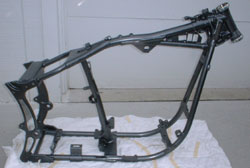
There are reasons motorcycle A weights less than motorcycle B, that weight was taken from somewhere. Sometimes it can be fine (using a different type of material for the frame over steel) and sometimes it is bad (thinner engine walls, less metal in the frame, hollowing out parts).
Let’s take the Suzuki GSX-R750 again from above and by the way I’m not picking on the GSX-R750, it is an amazing motorcycle (maybe even #1 in it’s class). And let’s use the Honda Rebel 250. OK, I’ll give you that one is a sport bike and one is a cruiser, but we are looking at the weight more than anything.
The GSX-R weights in at: 166kg (and produces 141hp)
The Rebel weights in at: 139kg (and produces 18hp)
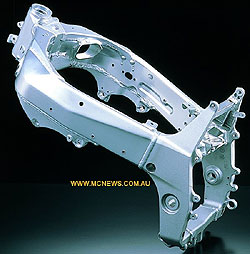 27kg in weight difference from a 250cc to 750cc! So, how do you make a 750cc that light! It isn’t that the Rebel 250cc is a heavy bike for it’s size, it is light as bikes go. So, where did the weight go? Since I’ve worked on a new GSX-R750, let me tell you…Combine: Thinner engine side walls, lightest engine internals, hollow bolts, thin plastic, the narrowest gauge wiring possible, thinnest frame thickness possible and you are just scratching the surface. While this engine isn’t under stress from the bike’s weight, it just won’t last as long as it could if the design allowed for more weight tolerance. Of course if the bike weighted more, it wouldn’t be the same either, but then if would last longer…
27kg in weight difference from a 250cc to 750cc! So, how do you make a 750cc that light! It isn’t that the Rebel 250cc is a heavy bike for it’s size, it is light as bikes go. So, where did the weight go? Since I’ve worked on a new GSX-R750, let me tell you…Combine: Thinner engine side walls, lightest engine internals, hollow bolts, thin plastic, the narrowest gauge wiring possible, thinnest frame thickness possible and you are just scratching the surface. While this engine isn’t under stress from the bike’s weight, it just won’t last as long as it could if the design allowed for more weight tolerance. Of course if the bike weighted more, it wouldn’t be the same either, but then if would last longer…
So to conclude: More solid, heavier parts, wires, plastic (etc) with greater weight tolerance will last longer than those made to minimum specifications. It just makes sense.
Trade Secret Tip #3:
Move less, live Longer
Engineers have known for a very long time that the less moving parts you have the greater reliability potential of any part is. Take a tire iron, zero moving parts = last almost forever. Take a jet fighter = zillion moving parts….
All motorcycles are pretty much created equal by nature. They have 2 tires, a frame, seat, handlebars, brakes, but the engine is what sets them really apart. If you have been reading this so far, you have gotten the idea that the engine can be the most important part in reliability. If the engine dies you don’t have much of a motorcycle left even if the other parts are in great shape. 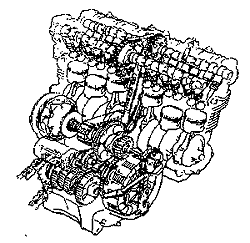
So it then comes to reason that the less moving parts you have in an engine the longer it could last. Just to straighten things out we are not talking about an engine design (sport bike, cruiser, 2 stroke etc), but the amount of moving parts in it.
Let’s use this example, take Honda CBX Six (1000cc inline 6). It has six pistons, 24 valves, and loads of parts in between. Not only can it be a mechanical nightmare to work on, but the chance of something just needing a replacement part in there somewhere is very high (not to mention the repair bill). If that gives you a headache, let’s take the Suzuki Savage 650. Single cylinder, single carb, and much less moving parts, less chance for something to go wrong and even saves you money in the long run.
So look for less complex designs not only in the engine department but also in the whole bike. More electronics, lights and gadgets look great but can quickly burn out and need upkeep. Chains are lighter than shaft drives, but are not as reliable or as cost effective. Hydraulic valves might cut 1-5% top end horsepower but are more reliable than shim type valves. Just remember, less complex = more potential reliability.
Trade Secret Tip #4:
Lower beats per minute, more relaxed state.
As with humans, if our heart beat too fast for too long, we could die. Same with motorcycle engines. Push the RPM into the red line one too many times and that engine’s life expectancy will drop to one day it just won’t want to run anymore.
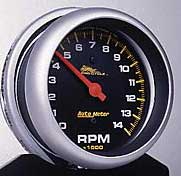 As an engine runs into its high RPM range many things happen. Oil is the life blood of an engine and as it gets hotter it’s viscosity brakes down quickly and doesn’t do as effective of a job. The engine can overheat causing metal fatigue, internal damage and wear. Some items shrink with too much heat such as O-rings, seals and gaskets causing leaks. Scoring of the piston(s) and chamber is also a concern.
As an engine runs into its high RPM range many things happen. Oil is the life blood of an engine and as it gets hotter it’s viscosity brakes down quickly and doesn’t do as effective of a job. The engine can overheat causing metal fatigue, internal damage and wear. Some items shrink with too much heat such as O-rings, seals and gaskets causing leaks. Scoring of the piston(s) and chamber is also a concern.
While it is safe and fun to blast away into the red zone under some conditions it is self-defeating to an engine in the long run to do it one too many times.
On the other side of the coin, you do not wish to “Lug” an engine by riding in too low of a RPM. This also places a lot of stress on an engine.
So what do you look for? Mostly the owner of the bike. A typical owner will not only maintain the bike but will also ride the bike properly. Stay away from raced bikes or bikes with lots of kilometers in the hands of timid riders. A timid rider could be the GSX-R750 owner who never takes the bike over 4,500rpm.
Trade Secret Tip #5:
New Version 5,431.101 just released!
Some motorcycle models just keep getting built year after year for a dozen years or more with slight “improvements” to keep it up to date sometimes. This is a tricky tip and can be good or bad depending on the revision history of the model.
This is where you as a buyer have to play detective and figure out the history of the models and what changes took place. You may discover that some years are much better than others and some years you avoid like the plague.
If they are still using basically the same engine for 10+ years and they “increased” horsepower by 5hp, what did the do to do that? If the bike lost 25 lbs in 10 years, where did they shave it off from? What did it loose or gain along the way?
Conclusion:
Well, that is all I can think of right now for tech tips on what to look for in reliability. Some of the tips are really good, others you probably already know. So does this all lead up to a dull motorcycle? Not at all, is just means that you will know how to pick a motorcycle you love and have the relationship last longer.
Now the BEST tip I can give it non mechanical in nature. It is the owner of the bike tip. Always maintain your motorcycle, changing the oil like clock work being the #1, and any bike will last longer than it supposed to. Take care of your bike and it will take care of you.
Legend:
Pricing: Year Pricing is picked by myself to give an accurate idea of pricing over the years. It is not an indication of what year of that model to look for or the only years that model was made. Pricing is also just a guideline since pricing in your area or country maybe higher or lower than in the price guides. Prices are from North America and Australian buy and sell values and these prices may not be accurate all over the world. 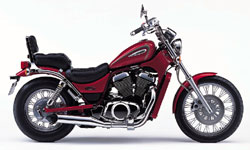
Models/Years Offered: Not all models and years maybe offer in your area/country. Models and years are taken from North America, United Kingdom and Australia. The models chosen are/were based on reliability, value, and best model made recommendations from books, guides, mechanics and motorcycle shops. Actual opinions may differ and if you would like to suggest a bike, feel free to do so.
Engine Size: An effort was made to only include models 800cc and under where possible to help first time, second bike and returning riders to the sport. There are many good models above 800cc on the market, and may be included later in another Buyers Guide on this site if there is demand for them.
Statistics: Actual manufacturer’s model statistics were used were available. When not available reliable statistics were used based on books, fan sites, and other reference guides. If there is a statistic missing from a model and you know what it is, please feel free to email it to me with the source of where you got it from to retain accuracy in this Guide.
Photos: Every effort has been made to use actual brochure photos of the different models. Failing to find a brochure photo the very best photo was found on the Internet depicting that model. If you have a better photo of any model here, please feel free to submit it to me for consideration.
Links: Feel free to add a link from your website to this Buyer’s Guide, please do not link individual sections (e.g. Honda), but link the Main section (Buyer’s Guide Index) since individual sections will be moving/moved around.
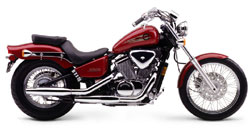 Descriptions: Actual manufacturer’s descriptions were used were available. When not available reliable descriptions from brochures, magazines and ads were used for that particular model.
Descriptions: Actual manufacturer’s descriptions were used were available. When not available reliable descriptions from brochures, magazines and ads were used for that particular model.
Notes: This is what is known about a particular model (common knowledge), as well as any opinions commonly expressed about the model as well. Any important information from other sources about the model will be displayed here as well as the source of information.

